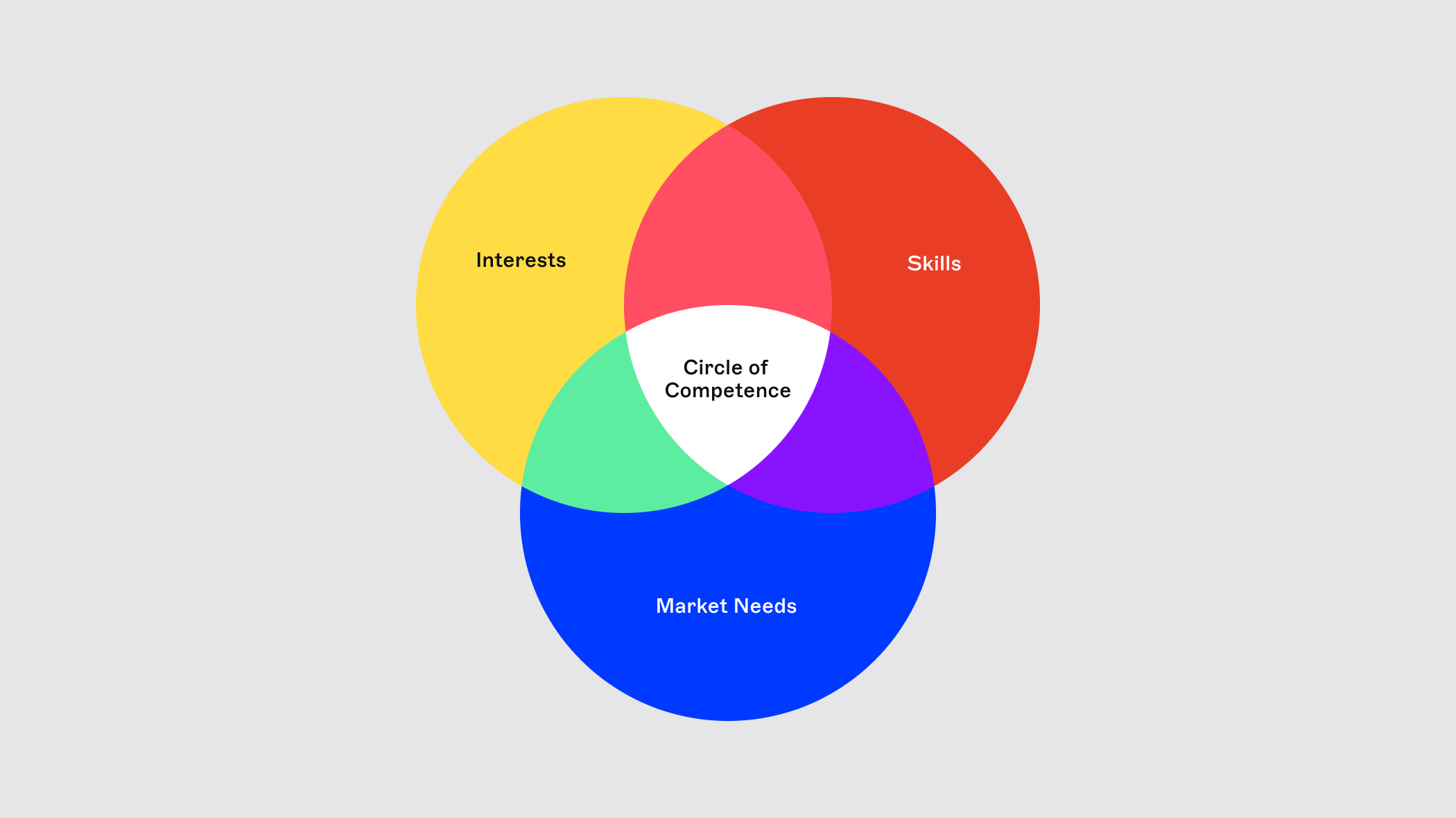

If you've been trying to grow your audience, content, or business for any amount of time, you've undoubtedly heard:
"Just pick a niche."
"You should niche down."
"The riches are in the niches."
These statements might seem cliche by now, but the intention behind them still rings true.
You should narrow your focus. Otherwise, your audience, content, and business will be stuck in a slog of randomness.
Nonetheless, I've always had issues with statements like "Just pick a niche" or "You should niche down." They only tell half the story—that you should narrow your focus without explaining how to narrow it.
So, to make this overused advice more helpful, let's look at ways to find what most people call a "niche"—better known as finding your circle of competence.
A word before we get started
To find your circle of competence (aka your niche), you need to examine where your interests, skills, and market needs overlap.
Sounds simple, right? It can be—but it's not always easy.
You must be brutally honest about your talents, abilities, and the market you wish to serve.
Let's explore our circle of competence, starting with the first part of the Venn diagram: your interests.
1. Defining your interests
To write interesting content, you must be interested. And if you're going to spend a lot of time honed in on a particular topic—you damn sure better enjoy it.
It can be hard to commit to an interest once you realize how much time and attention you'll need to put in.
Before you let the ink dry on choosing an interest, ask yourself these questions:
- Would I feel passionate about this topic on both my best and worst days?
- Can I see myself exploring this topic without any incentives (money, audience, fame, etc.)?
- How does this interest align with my long-term business goals and/or lifestyle?
How you answer these questions will determine whether you're on the right track (or not).
Once you settle on an interest, the next step is to outline your unique skills.
2. Taking stock of your skills
The second component of finding your circle of competence is taking stock of your skills.
It might go without saying, but you should be brutally honest with yourself at this stage.
It's one thing to find an interest to pursue—it's another to identify skills you can bring to the table that set you apart from the field.
Like in the previous section, there are a handful of questions you should ask yourself at this stage. And again, you're not doing yourself any favors if you aren't being 100% honest.
- What am I qualified to do better than 99% of people?
- How do the strengths of my skills enhance my perspective? And how do they mitigate weaknesses that might seep through the cracks?
- Which of my skills has been validated by the open market through achievement, recognition, or payment?
- Can I combine both soft and hard skills to create a wholly unique skill set?
Make a list of things you're uniquely qualified to do. Then, move on to the most critical part of this entire process—researching what the market needs.
3. Finding product-market fit
By now, you've looked inward and should be confident in your interests and skills.
Now, it's time to look outward and determine what the market needs—and how to position yourself as the solution.
The #1 question you should ask yourself at this stage of competence evaluation is: "What specific problems does my audience have that I'm uniquely qualified to solve?"
If you can answer this question with absolute clarity, you're doing better than almost every creator on earth.
But if you need more data points, there are a few more topics you can explore around market needs:
How large is the potential audience in my circle of competence?
Selling wetsuits to underwater basket weavers might be where your interests and skills overlap. But something tells me that the market will be a little... minnow-scule (see what I did there?).
Knowing the TAM (Total Addressable Market) is key. You must know how much market share is available and how much you can realistically expect to influence.
How competitive is the market?
If the market you're interested in is wide open, this could benefit you. First-mover advantage has made a lot of people a lot of money.
But, if you're in a more crowded market, you will need to figure out how to differentiate your offering from your competitors.
This is Business 101, but it's worth repeating so you go into either scenario with your eyes wide open.

Putting it all together
Ok—you've done the work:
You are interested in a topic you could write about on good days and bad.
You've identified your skills with brutal honesty and know what sets you apart from the rest.
You've found your market. You know its needs and what makes you uniquely qualified to solve them.
The circle of competence Venn diagram is complete.
This is your "niche" or "pocket".
It's the sweet spot for personal fulfillment and content creation.
It's also where you're most likely to find audience engagement and authentically impact people.
But understand: Once you find your circle of competence, the real work begins.
You'll have to work hard to create great content and experiences for your audience. It must resonate and deliver on the promise of solving their specific needs.
This is where trust is built. And it's the first step towards convincing the audience to consider your offering.
It won't be easy, but that's the price of admission to stand out in today's crowded market landscape.
It's true: "The riches are in the niches." But only for those willing to fully dedicate themselves to their circle of competence.
So get out there—find, meet, and exceed your audience's needs. They're waiting for you to share the unique value only YOU can provide.
If you like these articles, you'd love my newsletter, Digital Native.
Get real-world lessons from a decade's worth of digital business know-how, delivered to your inbox every Saturday at 8 AM ET.
Join hundreds of creative founders





























